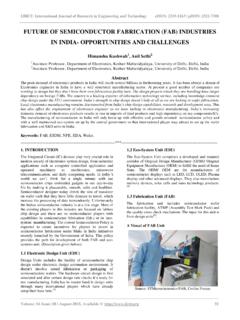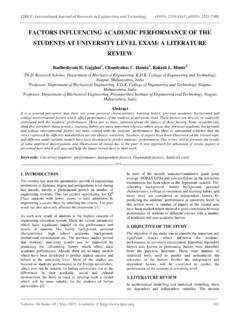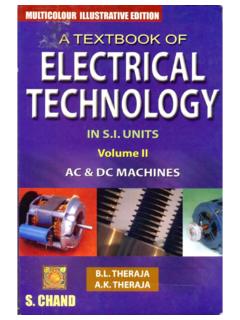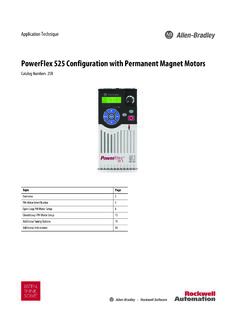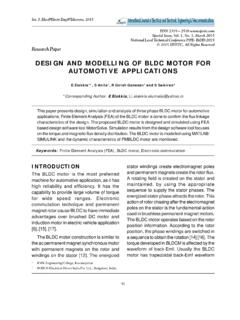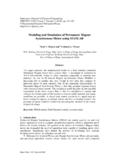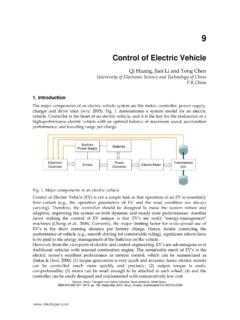Transcription of COMPARISON OF ELECTRIC MOTORS FOR ELECTRIC …
1 IJRET: International Journal of Research in Engineering and Technology eISSN: 2319-1163 | pISSN: 2321-7308 _____ Volume: 06 Issue: 09 | Sep-2017, Available @ 12 COMPARISON OF ELECTRIC MOTORS FOR ELECTRIC VEHICLE APPLICATION Swaraj Ravindra Jape1, Archana Thosar2 , Electrical Engineering Department, Government College of Engineering, Aurangabad, Maharashtra, India 2 Professor, Electrical Engineering Department, Government College of Engineering, Aurangabad, Maharashtra, India Abstract ELECTRIC vehicles with higher energy efficiency, low maintenance cost and pollution free operation, are offering great alternative to popular conventional IC engine vehicles. Also, with the advancement in technology, ELECTRIC vehicle manufacturers are able to overcome the traditional drawbacks of ELECTRIC vehicles, making it more and more suitable for modern day transportation.
2 A motor in an ELECTRIC vehicle provides the necessary force for the propulsion of a vehicle, which makes it the heart of ELECTRIC vehicles. Different types of ELECTRIC MOTORS are compared on the basis of certain parameters which should be considered for selecting a particular motor type for ELECTRIC vehicle application. COMPARISON is tabulated for some parameters. Also, characteristic graphs of different MOTORS are included at some points. Keywords: ELECTRIC vehicle, DC brushed motor , BLDC motor , Induction motor , synchronous motor , Switched reluctance motor . ---------------------------------------- ----------------------------**---------- ---------------------------------------- --------------------1. INTRODUCTION In EV s, ELECTRIC energy is the main source of power for propulsion of a vehicle. In ELECTRIC vehicles, electrical energy is converted into mechanical (rotational) energy by ELECTRIC MOTORS .
3 This rotational energy is applied to wheels of a vehicle through an appropriate transmission system which in turn causes propulsion. A vehicle with four MOTORS can be considered as the most efficient model in ELECTRIC vehicles [1]. ELECTRIC vehicles can use ELECTRIC energy as a sole source of power or can use batteries in conjunction with gasoline engines to power the vehicle. Battery, ELECTRIC motor and controller are the core components of any ELECTRIC vehicle. ELECTRIC vehicle can be broadly represented as shown in Figure 1. Fig-1: Basic components of an ELECTRIC vehicle ELECTRIC MOTORS are also specially designed for their specific use in ELECTRIC vehicles. ELECTRIC vehicles may incorporate AC or DC MOTORS as per design engineer s choice or depending on the intended use of ELECTRIC vehicle. Over the years there has been a significant research in the field of ELECTRIC MOTORS and different types of AC and DC MOTORS have been developed.
4 This gives ELECTRIC vehicle manufacturers a wide range of different ELECTRIC MOTORS to choose from as per their requirement. Selection of a particular type of motor for an ELECTRIC vehicle must be done judiciously as motor characteristics affect the overall performance of a vehicle. 2. MOTORS COMMONLY USED IN EV s Different types of motor exhibit different characteristics, which makes it important to evaluate MOTORS on some basic parameters for choosing a particular type of motor for an ELECTRIC vehicle. ELECTRIC MOTORS used in ELECTRIC vehicle should have important attributes like simple design, high specific power, low maintenance cost, and good control. MOTORS that are widely used by ELECTRIC vehicle manufacturers are DC brushed MOTORS , DC brushless MOTORS , Induction (Asynchronous) motor , synchronous motor , Switched Reluctance motor .
5 DC Brushed motor In DC brushed motor , brushes along with commutators provide a nexus between external supply circuit and armature of the motor . Brushes can be made up of carbon, copper, carbon graphite, metal graphite and are mostly rectangular in shape [2]. Wearing of commutators due to continuous cutting with brushes is one of the main drawbacks of DC brushed MOTORS . Also, friction between brushes and commutators, limits the maximum motor speed. IJRET: International Journal of Research in Engineering and Technology eISSN: 2319-1163 | pISSN: 2321-7308 _____ Volume: 06 Issue: 09 | Sep-2017, Available @ 13 Fig-2: Brush and Commutators arrangement DC brushed MOTORS have the ability to achieve high torque at low speeds, which makes them suitable for traction system [3].
6 Figure 2 shows simple brush and commutators arrangement in DC brushed MOTORS . Depending upon power output and voltage rating, DC brushed MOTORS can have two, four or six poles and the field winding may be series or shunt connected. Poor power density as compared to PMSM or BLDC motor is another drawback of brushed DC motor for use in ELECTRIC vehicles. DC Brushless motor DC brushless motor provides certain advantages over DC brushed motor , like less maintenance and higher efficiency. Mechanical commutation as in brushed DC motor is replaced by equivalent electronic commutation (inverter circuit and rotor-position sensing element) circuit in DC brushless motor [3], [4]. Fig-3: Basic arrangement of rotor and sensor elements in BLDC motor According to National Electrical Manufacturers Association (NEMA), BLDC motor is defined as rotating self- synchronous machine with a permanent magnet rotor and known rotor shaft positions for electronic commutation [5].
7 Figure 3 shows basic arrangement of stator, rotor and position sensors in BLDC motor . BLDC motor provides higher torque at the peak values of current and voltage as compared to other MOTORS [4]. Due to better operating characteristics at higher speeds, these MOTORS find their application in compressors, pump and ventilation system. Induction (Asynchronous) motor Three phase induction MOTORS are widely used in ELECTRIC vehicles because of high efficiency, good speed regulation and absence of commutators. Three phase AC supply is connected to stator winding, due to which revolving magnetic field is established. This revolving magnetic field interacts with stationary rotor conductors, and induced current flows through rotor conductors. Induced current establishes its own magnetic field. Interaction between revolving magnetic field and field due to induced currents gives rise to unidirectional torque [3].
8 As speed of rotor is different (less) than speed of revolving field ( synchronous speed), these MOTORS are also called as asynchronous motor . synchronous motor In synchronous MOTORS , rotor rotates at synchronous speed. The rotor is excited from a DC supply, while stator is connected to a three phase AC supply. Therefore, polarities of stator poles are continuously changing while rotor pole polarities are constant. Fig: 4 (a) Rotor sand stator poles having same polarity Fig: 4 (b) Rotor and stator poles having opposite polarity and rotor is rotated by external means Consider that initially stator and rotor are having polarities as shown in Figure 4(a). At this instant rotor S-pole is repelled by stator S-pole. Now, during another half-cycle, stator poles will change their polarities and now rotor S-pole will be attracted towards stator N-pole. Thus, rotor will experience pulsating torque and due to rotor inertia, it will not rotate in either direction.
9 Therefore, synchronous motor IJRET: International Journal of Research in Engineering and Technology eISSN: 2319-1163 | pISSN: 2321-7308 _____ Volume: 06 Issue: 09 | Sep-2017, Available @ 14 does not have self-starting toque. Now, if the rotor is rotated by external means such that rotor poles are continuously under the influence of stator poles of opposite polarity even with continuously changing polarity, rotor will start rotating in one direction. Figure 4(b) shows rotor S-pole and stator N-pole interlocked with each other and rotor rotating in clockwise direction. Now, even if external means are removed, rotor and stator poles are interlocked, and rotor will rotate with synchronous speed. Rotor should be rotated with such speed that it moves through a distance of pole pitch within half time period of supply.
10 Due to its high efficiency and high torque density, synchronous motor finds its application in servo, wind turbine and ELECTRIC vehicles [6]. Switched Reluctance motor (SRM) Switched reluctance motor produces torque by variable reluctance method. When stator coils are energized, variable reluctance is set up in the air gap between the stator and the rotor. Rotor tends to move to a position of least reluctance thus causing torque. Switched Reluctance motor has characteristics like high starting torque, wide speed range and good inherent fault-tolerance capability, which makes it suitable for ELECTRIC vehicle application [7].Some parameters that must be taken into account while comparing above MOTORS for choosing a best suited motor for required ELECTRIC vehicle application are power-to-weight ratio, torque-speed characteristics, efficiency, cost of controller, cost of motor [8].


